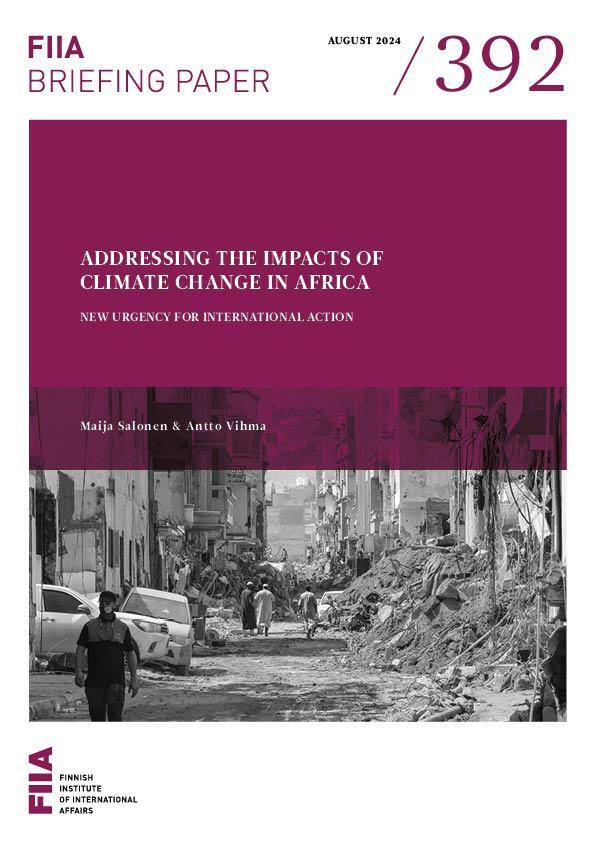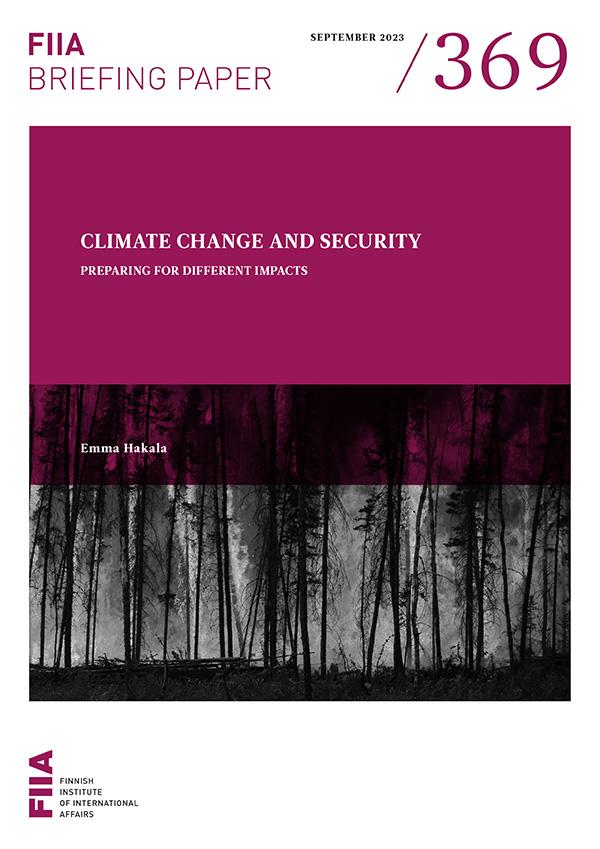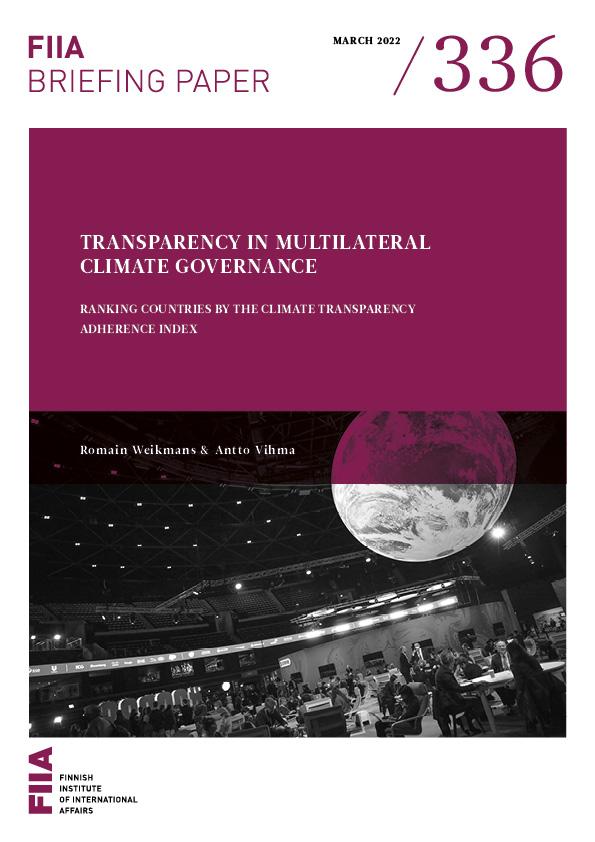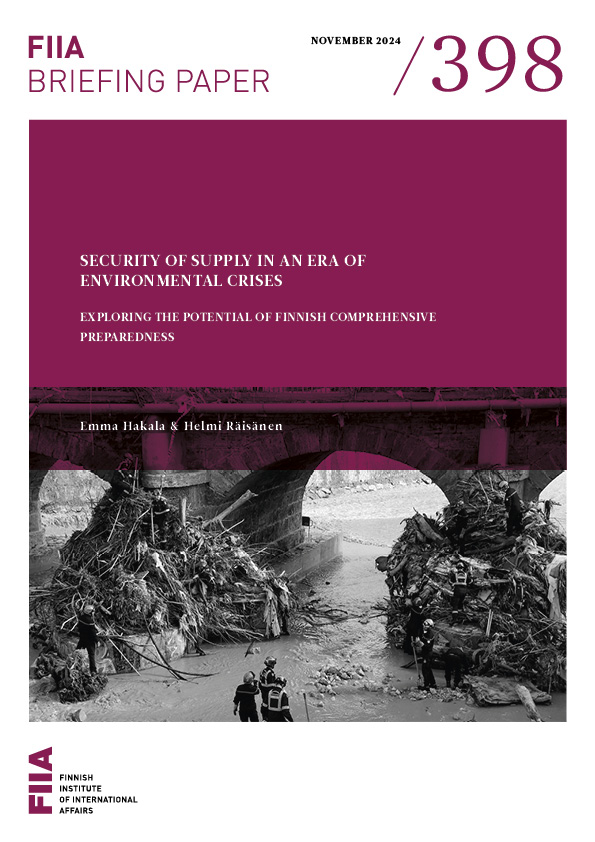
The drought in the Horn of Africa in 2020–2023 and the floods in Libya in September 2023 are recent examples of climate change-induced disasters that were exacerbated by a lack of adaptive capacity.
In the Horn of Africa, up to 2.7 million people were displaced by extreme weather events, and the catastrophic floods in Derna, Libya, killed approximately 11,000 people.
In addition to the direct impacts, there is a need to understand the cascading impacts of climate change, which are likely to increasingly affect societal security. At present, the risks are growing faster than societal preparedness.
The EU should raise political awareness of climate disasters and their cascading impacts. The ground needs to be prepared for decisive and ambitious climate change mitigation, and developed countries should offer continuous support for adaptation and capacity building.
Introduction
In 2023, almost every part of the African continent was affected by extreme weather events.[1] Meanwhile, much of world’s media attention has understandably been centred on warfare and geopolitical events. Indeed, with war returning to Europe in Ukraine, as well as close to European borders in Gaza, it is ever more challenging for climate change to gain the media coverage and public recognition it deserves. However, the slow and steady flow of climate change impacts and their various consequences in Africa should be included among the pressing issues of global politics. These impacts have implications for societal security in Africa, and are also of strategic importance for the EU.
Climate change causes droughts, floods, prolonged heatwaves, more intense storms and rainfall, and rising sea levels. In Africa, the impacts of climate change pose a major challenge to agriculture and pastoralism – livelihoods on which many countries depend. According to the World Meteorological Organization, agricultural productivity on the continent has fallen by 34% since 1961 due to climate change.[2] Deteriorating living conditions are causing migration, as well as local conflicts, forcing people and groups to compete for scarce natural resources. These security implications serve as a reminder that climate change impacts are not local; their cascading effects are global.
There is also an imbalance at the heart of climate change: the impacts are felt by those who contribute little to the problem. For example, African countries emit about 4% of global greenhouse gas emissions, but many are particularly vulnerable to climate change impacts.[3] This highlights the case for European funding for climate adaptation in Africa.
This Briefing Paper examines two recent examples that illustrate the current climate change impacts in Africa: the drought in the Horn of Africa in 2020–2023 and the floods in Libya in September 2023. The paper also discusses how such impacts may cross borders, what kind of cascading impacts Europe will face in the future, and what kind of approach the EU should adopt on the issue.
Drought in the Horn of Africa
The Horn of Africa suffered a severe drought in 2020–2023, with Ethiopia, Somalia, and Kenya hit particularly hard. Five consecutive rainy seasons failed, causing the worst drought in the Horn of Africa region for 40 years. This led to major crop, pasture and livestock losses, as well as widespread water shortages. Consequently, it also caused high food prices.
After four years of drought, unusually heavy rains hit the region in September–November 2023. The parched soil did not absorb the water, and floods hit vulnerable communities already suffering from loss of livelihoods, malnutrition and hunger. According to estimates, the crisis left some 23 million people in severe food insecurity.[4] Up to 2.7 million people have been displaced by the extreme weather events, and many are still living in refugee camp conditions.
Eastern Africa is characterized by alternating periods of drought and heavy rainfall. The alternation is caused by a weather phenomenon known as the Indian Ocean Dipole, which originates from the difference in sea surface temperatures between the eastern and western regions of the Indian Ocean. During the positive phase, the Western Indian Ocean becomes warmer, bringing heavy rainfall to the Horn of Africa. During the negative phase, the Western Indian Ocean becomes colder, often causing droughts in the region. Climate change is intensifying this effect, making the drought conditions harsher and, on the other hand, causing even heavier and more frequent rainfall.
According to World Weather Attribution research, weather conditions in the Horn of Africa in 2020–2023 would not have led to severe droughts in a 1.2°C cooler world. Droughts of this magnitude have become about 100 times more likely due to climate change.
Climate change impacts pose a particular challenge for food production, as farming in the Horn of Africa is highly dependent on rainfed agriculture. The region typically experiences two distinct rainy seasons, including the “long rains”, which are more intense and occur from March to May, and the less intense “short rains” from October to December. Climate change is causing unpredictable variations in these rainy seasons. Added to this, the droughts increase soil degradation and desertification.
Ultimately, however, the Horn of Africa is vulnerable to climate change and extreme weather events for societal reasons. Somalia and Ethiopia are Least Developed Countries (LDCs, as defined by the UN), suffering from poverty, conflict, poor governance and infrastructure, and lack of investment. The governments have weak capacities to help people living in protracted displacement, and their ability to adapt and manage the effects of climate change is severely limited.
Floods in Libya
Perhaps the most dramatic climate-related disaster in recent years occurred in Libya in September 2023, when floods claimed the lives of approximately 11,000 people. The catastrophe was caused by a storm over the Mediterranean Sea, which intensified as it moved towards north-eastern Libya, unleashing torrential rainfall. The deluge led to the collapse of two Wadi Derna River dams, releasing a massive surge of water that swept through the city of Derna in tsunami-like waves, wiping out entire neighbourhoods.
What were the climatic factors that contributed to this catastrophe? First, sea surface temperatures in the Mediterranean have been rising steadily since the 1980s. The region has witnessed unusually high sea surface temperatures every summer for the past few years. The summer of 2023 was extremely hot in southern Europe, causing the largest wildfires ever recorded in the EU in Greece. The heatwave was followed by the storm, which hit Libya the hardest.
As with tropical cyclones, high surface temperatures allow storms to gather more “fuel” as they travel over the ocean, making them stronger when they eventually make landfall. According to a study by World Weather Attribution, rainfall as extreme as that observed over Libya has become up to 50 times more likely and 50% more intense due to climate change.
Second, and related to the previous discussion on vulnerability, climate change impacts challenge the capacity of the government. The flooding in Derna exposed a severe lack of preparedness on the part of public authorities. There was no well-functioning system for warning the public about the incoming storm, and no evacuation orders were given. The dams, built in the 1970s, were in poor condition. Maintenance was delayed, first because the state did not pay the company hired to do the maintenance, and later because the relevant companies left Libya when the revolution began in 2011. There had been serious concerns about the dams long before the disaster, and there are currently other dams in Libya, for example near Benghazi, which have raised similar concerns.
Furthermore, the dense and high-rise housing built close to the river was poorly constructed. Before the floods, it was estimated that up to 30% of Libya’s housing stock had been damaged, either due to the conflict or lack of maintenance.
This exemplifies the many interwoven challenges facing countries like Libya, where about 11% of the population are vulnerable to multidimensional poverty, the impacts of conflict and displacement, and external shocks. Prior to the floods, the International Organization for Migration estimated that there were 125,000 internally displaced people in Libya, with the floods adding an estimated 44,800 more. [5] These people are more exposed to the effects of extreme weather events, for example through lower quality housing or shelter, and have fewer resources for recovery.
In addition, many lost their jobs and livelihood as a result of the floods, especially in the agricultural sector, when the floodwaters destroyed agricultural land. Infrastructure, including the water and sanitation sectors, suffered major damage. The total reconstruction and recovery needs were estimated by the World Bank at USD 1.8 billion.
The Intergovernmental Panel on Climate Change (IPCC) predicts that coastal flood risks will increase in low-lying areas along 37% of the Mediterranean coastline, an area currently home to 42 million people.[6] In the future, the intensity of mid-latitude cyclones is likely to increase, making them more hazardous and producing stronger winds and rainfall. Due to its particular combination of multiple climate hazards and high vulnerability, the southern Mediterranean region is a hotspot for interconnected climate risks.
The challenge of cascading impacts
The two catastrophes discussed in this paper had several direct impacts – loss of life, loss of crops and livestock, and food and water shortages. In Libya, significant damage occurred to the physical environment, such as housing and infrastructure. The events obviously caused major economic losses.
The direct impacts are not the whole story, however. Importantly, cascading impacts occur when environmental changes are combined with socio-economic and geopolitical factors, forming chains of events that cross national borders. The recent examples discussed in this paper highlight that climate change has rather straightforward security-related cascading impacts.
Deteriorating living conditions, as well as conflicts intensified due to climate disasters, may force people to leave their homelands. These mechanisms are also at work in the Horn of Africa and Libya. Typically, migration takes place inside a country, or between neighbouring countries, but it is likely that some climate-related migration will be directed towards Europe in the future.[7]
In the Horn of Africa, climate change impacts may even disrupt fragile peace processes in the region.[8] Pastoralists and farmers are known to depend on the same dwindling resources, and conflicts over scarce natural resources may increase due to climate change impacts. In addition, water and food scarcity, and otherwise stressed livelihoods, can make people, especially young men, more vulnerable to recruitment by armed groups. Livelihood deterioration can thus trigger economic decline, but also threaten local or even national stability. [9]
Groups like al-Shabaab in Somalia have already taken advantage of climate change impacts to boost recruitment.[10] The Horn of Africa is an unstable region – Ethiopia and Somalia are still suffering from recent civil wars. Under poor and unstable living conditions, terrorist groups can expand their region of operation. This can then lead to increased migration from regions under their control, and across borders. In addition, the repercussions of stronger terrorist groups can also be seen in Europe. The fragility of Libya’s political and security landscape and economic situation, combined with the flood disaster, may fuel migration outside the African continent – particularly as Libya is a major transit point for migration from Africa to Europe.
Furthermore, the wider regional security landscape has cascading impacts. In Sudan, for example, the current war has been ongoing since April 2023 and has forced some 10 million people to migrate. They are mostly internally displaced, but have also crossed borders into neighbouring countries, including Libya and Ethiopia, increasing the pressure on the already fragile situation in these countries.
The EU has long fostered strategic partnerships with Africa, with the aim of developing trade relations between African and European countries. However, when the political attention and resources of African governments are consumed by the need to survive natural disasters and deteriorating living conditions, the development of trade relations takes a back seat. This situation is further exacerbated by the economic losses and business collapses caused by the effects of climate change.
What is to be done? First, the EU should ramp up support for climate adaptation in Africa. Mitigation plays only a minor role for many African countries, as their emissions are insignificant on a global scale. The opposite is true for adaptation. The least developed countries in the region are in particular need of continuous support for adaptation and capacity building. In the light of the cases described above, adaptation activities should include, for example, measures to improve food security and early warning systems.
Second, the EU should raise political awareness of the climate disasters now unfolding and their cascading impacts on Europe. In doing so, the EU should prepare the ground for decisive and ambitious climate change mitigation. Emissions need to be reduced significantly without delay in order to achieve the long-term targets, such as net-zero emissions by 2050.
Conclusions
The impacts of climate change in Africa are not a future concern; they are already happening, are irreversible for people alive today, and will become more pronounced in the short term, even if climate policies are successful. The African continent is a hotspot for multiple climate risks. However, political and public attention is lagging behind, as the spotlight is on more immediate concerns, such as the wars in Ukraine and Gaza. In an interconnected world, the war in Ukraine has also had a negative impact on Africa’s food security, mainly through decreased wheat imports.
Climate change exacerbates the effects of extreme weather events and disrupts everyday life. The security implications of climate change, including migration and local conflicts over scarce natural resources, place additional stress on poor countries. Several fragile and vulnerable states in Africa, including Libya and countries in the Horn of Africa discussed in this paper, face security problems that may escalate far beyond national borders and regions.
International action is crucial to address this multitude of problems. African countries need support and funding for climate adaptation and capacity building. Climate-related disasters in Africa are manifestly a matter of both humanitarian and strategic importance.
Endnotes
[1] Dunne, Daisy (2023) “Analysis: Africa’s extreme weather has killed at least 15,000 people in 2023”. Carbon Brief, 25 October 2023. https://www.carbonbrief.org/analysis-africas-extreme-weather-have-killed-at-least-15000-people-in-2023/.
[2] World Meteorological Organization (2023) “State of Climate in Africa 2022”. WMO-No 1330. https://library.wmo.int/viewer/67761/download?file=1330_State-of-the-Climate-in-Africa-2022_en.pdf&type=pdf&navigator=1.
[3] Dunne, Daisy (2022) “Analysis: Africa’s unreported extreme weather in 2022 and climate change”. Carbon Brief, 26 October 2022. https://www.carbonbrief.org/analysis-africas-unreported-extreme-weather-in-2022-and-climate-change/.
[4] World Food Programme (2023) “Research Assessment & Monitoring (Ram): More Than a Decade of Drought—Impacts and lessons learned across the Eastern Horn of Africa 2011-2022”, p. 2. https://reliefweb.int/report/ethiopia/more-decade-drought-impacts-and-lessons-learned-across-eastern-horn-africa-2011-2022-february-2023.
[5] The World Bank (2024) “Libya Storm and Flooding 2023 Rapid Damage and Needs Assessment”, p. 36. https://documents1.worldbank.org/curated/en/099353101242428521/pdf/IDU153d4e1711e33e145321b8881cf996ea3acf7.pdf.
[6] Intergovernmental Panel on Climate Change (2022) “Climate Change 2022: Impacts, Adaptation and Vulnerability”, Working Group II Contribution to the Sixth Assessment Report of the IPCC, p. 2235. https://report.ipcc.ch/ar6/wg2/IPCC_AR6_WGII_FullReport.pdf.
[7] Hugh, Brigitte & Sikorsky, Erin (2022) “Moving towards security: preparing NATO for climate-related migration”. NATO Review. https://www.nato.int/docu/review/articles/2022/05/19/moving-towards-security-preparing-nato-for-climate-related-migration/index.html.
[8] de Coning, Cedric H. et al. (2022) “Climate, Peace and Security Fact Sheet Ethiopia”. Norwegian Institute of International Affairs, NUPI. https://www.nupi.no/nyheter/climate-peace-and-security-fact-sheet-ethiopia.
[9] de Coning, Cedric & Krampe, Florian (2020) “Multilateral cooperation in the area of climate-related security and development risks in Africa”, Analysis, Norwegian Institute of International Affairs, NUPI. https://reliefweb.int/report/world/multilateral-cooperation-area-climate-related-security-and-development-risks-africa.
[10] Funnemark, Anne et al. (2022) “Climate, Peace and Security Fact Sheet Somalia”. Norwegian Institute of International Affairs, NUPI. https://www.nupi.no/nyheter/climate-peace-and-security-fact-sheet-somalia3.










